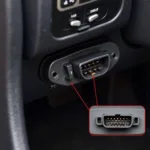High flow catalytic converters are a popular aftermarket modification for car enthusiasts looking to boost their vehicle’s performance. But how do they impact your car’s OBD2 system, and what do you need to know about OBD2 scanners in this context? This comprehensive guide delves into the world of high flow catalytic converters, their relationship with OBD2, and how the right OBD2 scanner can help you monitor your vehicle’s health.
Understanding High Flow Catalytic Converters
A catalytic converter is a crucial component of your car’s exhaust system, responsible for reducing harmful emissions. It does this by converting toxic gases like carbon monoxide, nitrogen oxides, and hydrocarbons into less harmful substances like carbon dioxide, nitrogen, and water vapor.
High flow catalytic converters, as the name suggests, are designed to allow exhaust gases to flow more freely. This is achieved by using a less restrictive honeycomb structure inside the converter, which presents less resistance to the exhaust flow. This improved flow can lead to several benefits:
- Increased horsepower and torque: The reduced back pressure allows the engine to “breathe” better, resulting in a noticeable increase in power output.
- Improved engine efficiency: By reducing the effort required to expel exhaust gases, the engine can operate more efficiently, potentially leading to slightly better fuel economy.
- Enhanced engine sound: For many car enthusiasts, the throatier, more aggressive exhaust note produced by a high flow catalytic converter is a desirable side effect.
High Flow Catalytic Converters and OBD2: The Connection
While high flow catalytic converters offer potential performance benefits, they can also trigger your car’s OBD2 system. Here’s why:
The OBD2 system continuously monitors various aspects of your vehicle’s emissions control system. One crucial parameter it tracks is the efficiency of your catalytic converter. When you install a high flow catalytic converter, the OBD2 system might detect a change in the exhaust gas readings compared to the factory-installed converter. This discrepancy can trigger a check engine light and store a diagnostic trouble code (DTC) in the system’s memory.
Choosing the Right OBD2 Scanner for High Flow Catalytic Converters
Not all OBD2 scanners are created equal. When dealing with high flow catalytic converters, you need a scanner that can do more than just read and clear basic engine codes. Here’s what to look for:
- Advanced diagnostics: The scanner should be capable of reading manufacturer-specific codes, live data streams, and oxygen sensor readings. This will provide a comprehensive understanding of your vehicle’s emissions system and help pinpoint any issues related to the high flow catalytic converter.
- Live data monitoring: The ability to monitor live data streams from various sensors, including oxygen sensors and mass airflow sensors, is crucial for assessing the performance of your high flow catalytic converter.
- Compatibility: Ensure the scanner is compatible with your vehicle’s make, model, and year. Some scanners are specifically designed for certain car brands and may offer enhanced functionality.
Benefits of Using an OBD2 Scanner with High Flow Catalytic Converters
- Early problem detection: By regularly monitoring your vehicle’s OBD2 system with a scanner, you can detect potential issues with your high flow catalytic converter before they escalate into costly repairs.
- Performance optimization: Analyzing live data streams allows you to fine-tune your vehicle’s performance after installing a high flow catalytic converter.
- Peace of mind: Knowing that you can monitor your vehicle’s health and address any potential issues quickly provides invaluable peace of mind.
Frequently Asked Questions
- Will a high flow catalytic converter void my car’s warranty? – Installing aftermarket parts, including high flow catalytic converters, can potentially void your car’s warranty, especially if the modification is deemed to have caused damage. Consult your vehicle’s warranty terms and conditions or contact your dealership for clarification.
- Can I install a high flow catalytic converter myself? – While it’s technically possible to install a high flow catalytic converter yourself if you possess advanced mechanical skills, it’s generally recommended to have it professionally installed by a qualified mechanic.
- How often should I check my OBD2 system after installing a high flow catalytic converter? – It’s a good practice to check your OBD2 system regularly, especially after installing a high flow catalytic converter. A monthly check should suffice for most users.
Conclusion
High flow catalytic converters can be a valuable upgrade for enhancing your vehicle’s performance, but it’s crucial to be aware of their potential impact on your car’s OBD2 system. Investing in a reliable and feature-rich OBD2 scanner is essential for monitoring your vehicle’s health, ensuring optimal performance, and addressing any potential issues promptly. By being proactive and informed, you can enjoy the benefits of a high flow catalytic converter without compromising your vehicle’s emissions control system.
Need help choosing the right OBD2 scanner? Check out our detailed reviews of Foxwell NT809BT Bluetooth OBD2 Scanner and OBD2 Scanner with ABS and SRS PC. We also have a guide on OBD2 Scan Tool with Live Data that might be helpful.
For additional information on SSM OBD2 Bluetooth technology or to understand if BlueDriver software works with any OBD2 scan tool, browse our website or contact our dedicated support team available 24/7 via WhatsApp: +1(641)206-8880 or Email: [email protected].


